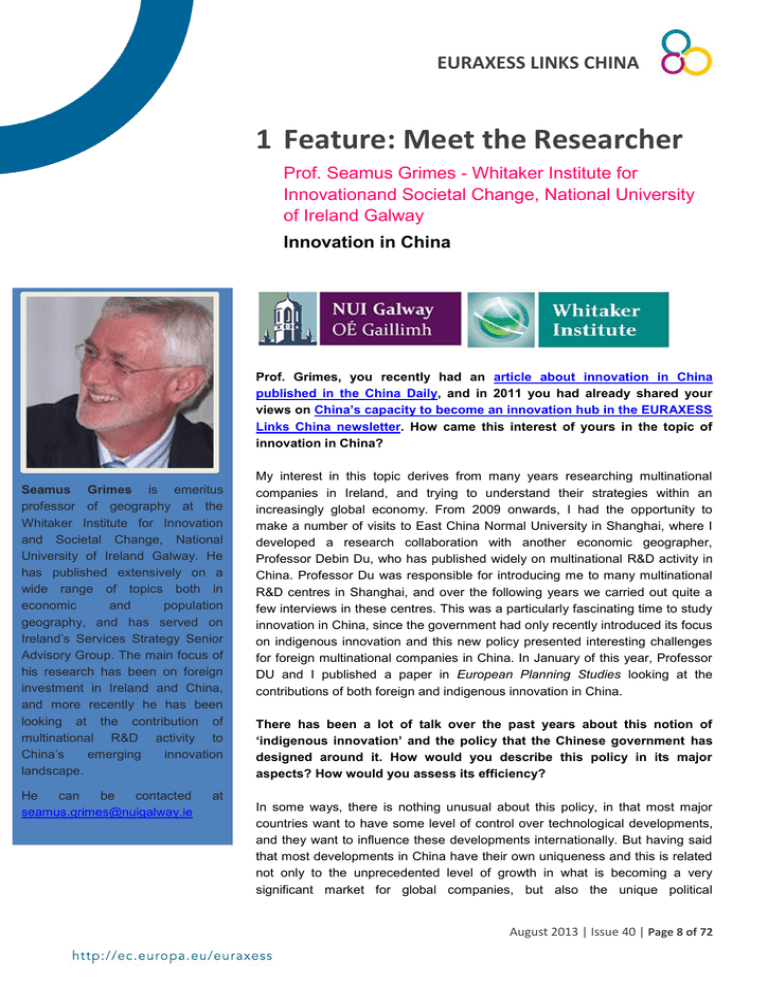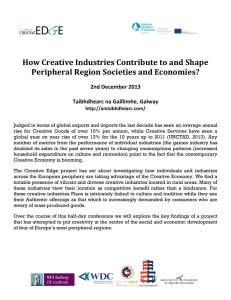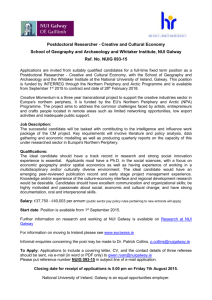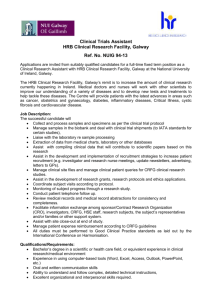1 Feature: Meet the Researcher EURAXESS LINKS CHINA
advertisement

EURAXESS LINKS CHINA 1 Feature: Meet the Researcher Prof. Seamus Grimes - Whitaker Institute for Innovationand Societal Change, National University of Ireland Galway Innovation in China Prof. Grimes, you recently had an article about innovation in China published in the China Daily, and in 2011 you had already shared your views on China’s capacity to become an innovation hub in the EURAXESS Links China newsletter. How came this interest of yours in the topic of innovation in China? Seamus Grimes is emeritus professor of geography at the Whitaker Institute for Innovation and Societal Change, National University of Ireland Galway. He has published extensively on a wide range of topics both in economic and population geography, and has served on Ireland’s Services Strategy Senior Advisory Group. The main focus of his research has been on foreign investment in Ireland and China, and more recently he has been looking at the contribution of multinational R&D activity to China’s emerging innovation landscape. He can be contacted seamus.grimes@nuigalway.ie My interest in this topic derives from many years researching multinational companies in Ireland, and trying to understand their strategies within an increasingly global economy. From 2009 onwards, I had the opportunity to make a number of visits to East China Normal University in Shanghai, where I developed a research collaboration with another economic geographer, Professor Debin Du, who has published widely on multinational R&D activity in China. Professor Du was responsible for introducing me to many multinational R&D centres in Shanghai, and over the following years we carried out quite a few interviews in these centres. This was a particularly fascinating time to study innovation in China, since the government had only recently introduced its focus on indigenous innovation and this new policy presented interesting challenges for foreign multinational companies in China. In January of this year, Professor DU and I published a paper in European Planning Studies looking at the contributions of both foreign and indigenous innovation in China. There has been a lot of talk over the past years about this notion of ‘indigenous innovation’ and the policy that the Chinese government has designed around it. How would you describe this policy in its major aspects? How would you assess its efficiency? at In some ways, there is nothing unusual about this policy, in that most major countries want to have some level of control over technological developments, and they want to influence these developments internationally. But having said that most developments in China have their own uniqueness and this is related not only to the unprecedented level of growth in what is becoming a very significant market for global companies, but also the unique political August 2013 | Issue 40 | Page 8 of 72 EURAXESS LINKS CHINA environment in China, with considerable intervention by the state in the economy and the market. Yet some would argue that China is one of the most capitalistic countries to be found anywhere, but it is very much capitalism with Chinese characteristics. Having succeeded for many years to attract record levels of foreign investment to China, the government is obviously re-evaluating the contribution which this investment has made in terms of technology transfer to local companies. Despite the considerable pressure by the state on foreign companies to share technology with local companies, the results have been disappointing to date, with most studies showing few spillovers taking place. Even though many of the companies I interviewed showed a willingness to have some level of give and take in their relationship with China, the underlying model of the global corporation is not designed to share vital intellectual property with companies that could easily become competitors. Also China, like other major countries views the importance of controlling technology developments in terms of its own security, particularly in areas like telecommunications and the internet sector. In this globalizing era, it becomes more difficult and also unrealistic for states to seek to place boundaries around the development of technology. Hence, while China has invested massively in increasing its social and physical infrastructure in order to become more attractive for innovation and R&D activity, the reality is that the major innovation hubs for technology development continue to be located in more developed regions, and China’s key challenge is to become more interconnected with these major hubs. My own view is that the indigenous innovation policy, while being completely understandable in terms of the objectives of the state, has to some extent fallen short of its objectives, and this may be partly because of the internal tensions within the policy. Part of these tensions arise from the need to get the balance right between developing and controlling technology within its own borders and benefiting to the maximum from involvement in global innovation networks. There appear to be some signs that Chinese leaders have recognized these limitations and in a typically pragmatic manner, they will adjust the policy accordingly. In your article recently published in the columns of the China Daily, you describe innovation taking place in China as being mainly incremental. What key conditions would need to be met for China to trigger the move from incremental innovation to radical innovation? Do you believe that there is the will on the Chinese authorities’ side to realize these conditions and do you think they will succeed or are the obstacles still too big? I would not like to give the impression of underestimating China’s ability to innovate, because I think that many foreign investors in China have failed in this market by such complacency. Innovation in the end must result in increasing market share. Otherwise, it may result in interesting products and processes that have no real impact. Because of the scale of the Chinese market, which in the case of foreign companies is the middle tier market that is growing rapidly, sectors such as the internet and mobile telephony are experiencing a dynamic evolution in terms of client base and demands from the market that are August 2013 | Issue 40 | Page 9 of 72 EURAXESS LINKS CHINA unprecedented. This creates an exciting environment for innovation, but it also creates an environment in which local companies can enrich themselves relatively easily by merely adding incremental features to existing technology. The reality is that it is very difficult to specify any particular technology that has been created in China in recent times. Yet, in terms of capturing market share, even though foreign companies by being better connected internationally to technological hubs have major advantages, this may not be reflected in their market share in China. To some extent, this results from the ability of local companies to be more cost-effective and also their greater familiarity with the local market, but there is little doubt that there is also a policy of protectionism associated with indigenous innovation. It is particularly difficult for foreign companies to capture the public procurement market. So, while this could be seen as a successful policy in the short term, by providing an opportunity for local companies to make the transition to a more competitive environment, in the longer term, however, having such a large and to some extent protected local market is likely to slow the process of innovation and make it more difficult for Chinese companies to become more competitive globally. In terms of what China needs to do to become more innovative, I think that patience is required, but also creating an intellectual environment of independent and critical thinking, in which questioning and even failure are not frowned upon is likely to facilitate greater innovation. Some would argue that Chinese policy in this area has been hampered by bureaucracy, and that the role of the state should be more focused on facilitating rather than directing China’s huge private sector to become more competitive internationally. In the same article, you also mention the currently risky IP environment as one of the main obstacles for China to become an innovation hub. What are the main factors explaining this current IP situation and how do you see it evolve in the close/foreseeable future? Most scholars acknowledge that China has already put a legal framework in place to protect IP. The problem for many companies is their lack of conviction about its implementation, and also the lack of political independence of the judiciary. As more Chinese companies such as Huawei, ZTE, Haier, BYD, etc acquire significant IP and become concerned about its protection, the IP environment in China will improve, but it is likely to take some years. Many companies I interviewed are still very wary about carrying out leading edge R&D activity in China. In most cases they are moving slowly. The general model seems to be to carry out R&D for products to be developed in China, and perhaps some similar markets, although many foreign-owned R&D centres in China also play an important role in feeding innovation into their global networks. In September 2012, at the last EU-China Summit, both sides formally decided to initiate a High-Level Innovation Cooperation Dialogue. Some EU-Member States already have such dialogues with China, and so do the US as well. How and to which extent can innovation be the object of August 2013 | Issue 40 | Page 10 of 72 EURAXESS LINKS CHINA cooperation and what role do you see for States-driven international “innovation cooperation”? The Whitaker Institute for Innovation and Societal Change applies a multi-perspective research approach to business and social issues, with an impact-led focus at the core of its endeavours. One of its key values is the promotion of a sustainable and inclusive society, influenced by the broad dissemination of rigorous and relevant research. Furthermore, the Whitaker Institute seeks to continue the tradition at NUI Galway of critically pursuing knowledge discovery that stimulates academic debates and opens public conversation to advance the greater good. I think that China can (and more than likely does) learn some lessons from the history of the EU’s Framework Programme of research and particularly its role in facilitating international networking. In the early stages of that programme there was a tendency to promote national champions, an approach that had little success. Over time, experience has shown the importance of international collaboration, although the sharing of commercial outcomes can be problematic. A general failure in many parts of the world by state policy is to more effectively integrate the R&D activity of foreign investors into the local economy. In many parts of the world, the state has tended to end up focusing on promoting some form of indigenous innovation and prioritizing its own companies. The fact is that in the contemporary global era with fragmented value chains and different locations and regions playing different roles in these value chains, it is vital to develop policies that are in tune with these realities rather than policies that are overly nationalistic in their design. So, while the EUChina Summit will undoubtedly help promote a more internationalized approach to policy development, it is also important for China to allow the market to play a more significant role in driving innovation. Prof. Grimes, thank you very much for the interview. The National University of Ireland, Galway, which was established in 1845, is a constituent college of the National University of Ireland. With a student population of 17,000, it is located in the small scenic city of Galway on Ireland’s west coast. August 2013 | Issue 40 | Page 11 of 72



